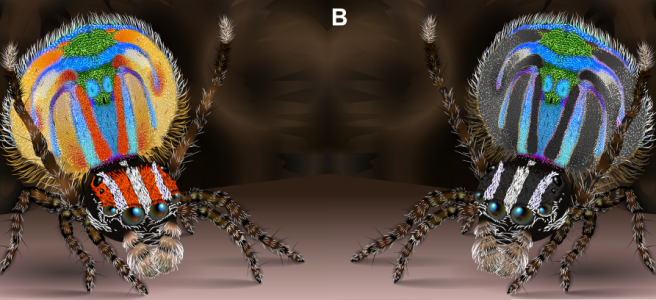How do animals choose their mates? Dr. Maddie Girard and Dr. Damian Elias were pretty sure they knew what female peacock spiders found sexy—it had to be the red. Found throughout Australia, these tiny jumping spiders have excellent vision, and instead of a making a web, they sneak, climb, and pounce to catch their food. … Continue reading Seeing red in a new light: Peacock spider courtship defies our human assumptions
Category: Behavior
New firefly breeding patterns light the way for changes in color vision
A staple of warm summer nights, fireflies have charmed generations with their magical evening glow. Children setting out to capture them in jars can tell you the trick is to catch sight of each flash of light as the bugs fly around. What we might not realize as children is that fireflies emit their greenish … Continue reading New firefly breeding patterns light the way for changes in color vision
If you talk the talk, you’ve got to walk the walk: mimicry of ant locomotion in jumping spiders
If it looks like an ant and walks like an ant, it must be an ant, right? Thanks to evolution, this isn’t always the case. Plants and animals can evolve to mimic other species in appearance, behavior, sound, or smell. By doing so, mimics can reap benefits such as increased access to food, enhanced reproduction, … Continue reading If you talk the talk, you’ve got to walk the walk: mimicry of ant locomotion in jumping spiders
I’ll have what she’s having: Manipulation in chimpanzee copulation calls
When we think about animal relationships, some endearing examples of devoted couples come to mind: emperor penguins that faithfully guard their hatchlings for weeks while they wait for their mate to return; love birds (not surprisingly) that groom and feed each other during courtship, and some species of monkeys that intertwine their tails as they … Continue reading I’ll have what she’s having: Manipulation in chimpanzee copulation calls
I’m looking at the fish in the mirror: a tail of social signaling
Just as we exploit social media to self-promote, find mates, and flaunt social status, animals use visual, olfactory, auditory, or mechanical displays to communicate with one another. Like a Facebook status, these displays often communicate some internal attribute about the organism. A well-known example of this type of signaling is the vibrant tail-feathers of the … Continue reading I’m looking at the fish in the mirror: a tail of social signaling
Tiny chompers: How a baby Cichlid behavior influences an adaptive trait
Think of a trait, any trait. A bird beak, a butterfly wing, a fish fin. Highly coordinated gene expression networks ultimately produce all traits. Hence, any variation you see in these traits must be due to shifts in gene expression, whether that shift is determined genetically or by some external cue. Evolutionary developmental biologists want … Continue reading Tiny chompers: How a baby Cichlid behavior influences an adaptive trait
Why the horned lizard has horns: More than a just-so story
Shrikes are basically nature’s version of Vlad the Impaler. While less gory birds feed on nuts and others peck at insects, shrikes impale their prey onto sharp spikes. Once the unfortunate animal is firmly attached and appropriately subdued, shrikes then tear their prey apart. The result is an array of dismantled corpses of lizards, small … Continue reading Why the horned lizard has horns: More than a just-so story
Love stings: Sexual selection on wasp spots
Sexual selection has resulted in some of the most flamboyant and outrageous ornaments in the natural world. The flashy plumes of the peacock tail, regal fringe of the lion’s mane, and vibrant colors of the agamid lizard all advertise males’ merits as mates to females. Although sexually selected traits are regularly observed in mammals, birds, … Continue reading Love stings: Sexual selection on wasp spots
Are male bats actually making echolocation harder to impress the ladies?
We tend to view sexual selection as secondary to natural selection, but nothing is second to the imperative to reproduce. Sometimes that means that even precisely engineered traits like echolocation have room to be a little sexier. Could falsetto calls really be a signal of male quality in the Mehelyi's horseshoe bat?
Untangling the spider’s web
The orb-weaving spiders build webs so spectacular and bizarre that it seemed they must also be one-of-a-kind. As Tauana Junqueira Cunha explains, modern phylogenetic techniques have now unraveled a tangled web of data to reveal the true story.










